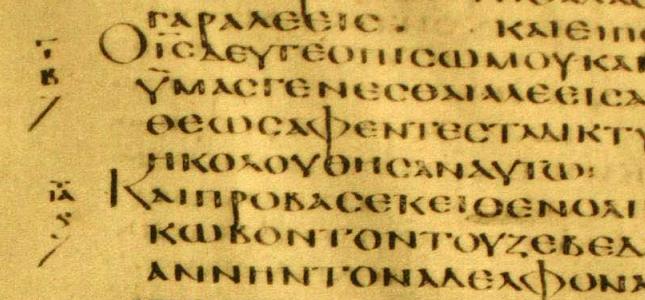|
Next we will look at the Eusebian Canon and how it is used. It is essentially a cross-reference system allowing the reader to find parallel sections in the other gospels.
Eusebius had a copy of a gospel harmony showing the parallels written by Ammonius the Alexandrian and was quite displeased with the resulting mess. Eusebius
then designed a new system which is the Eusebian Canon which can still be seen in NA27. The system is based on ten tables. Next to a section of a gospel is written two numbers. Look
at the picture below and notice the two entries in the left margin. Those are two separate Eusebian Canon references.
|

We shall use the top of the two entries shown above. It shows the particular entry on top (iota or 10) and the table to consult (beta or 2.) So we consult table number two (see below for a link
to the Eusebian Canon tables) and look for the number ten. We find it in the second entry and can see that the corresponding entries are 21 in Matthew and 32 in Luke. In order to find the actual
entry one would then scan, for example, Matthew and look for the Eusebian Canon entry in the margin that reads κα written above the letter β. κα is the number 21
which we got from the table and β is the table. The system is not perfect but it does work and can still be used when looking at old manuscripts.
Here is what we see when we look up our entry in Luke. Remember, we are looking for number 32 from table 2, which means we are looking for λβ over a β. Unfortunately, Luke has gotten
a little torn right there but we can still make it out.
|

For the actual tables, go here.
For further information on the Eusebian Canon, see here.
|
|